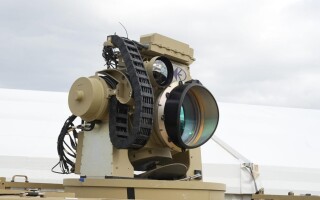Paradigm shifts underway for electromagnetic spectrum dominance
StoryMay 31, 2017

The electromagnetic spectrum is no longer primarily just a means for the military to communicate or sense the environment?it?s becoming a full-on warfare maneuver space.
Dominance of the electromagnetic spectrum is a multifaceted technique primarily used today by the military to improve the ability to sense and understand the surrounding environment and to characterize how adversaries are using the spectrum—where they’re located, what types of signals they’re using, why they’re using them.
Are our adversaries using the spectrum to communicate or using a radar to sense what we’re doing? Is it a jamming signal attempting to disrupt our ability to use the spectrum? These are just a few of the common questions the ability to sense the environment can answer.
“From an intelligence, surveillance, and reconnaissance (ISR) perspective, there are three key elements to spectrum dominance: the ability to use the spectrum as necessary, denying other actors the ability to use the spectrum, and to understand at any given time what’s transpiring within the spectrum,” says Mike Mabry, who works within the Chief Engineers Organization under Lockheed Martin’s C4ISR group.
Adversaries’ capabilities are increasing, which “ultimately drives how much we engage with the spectrum,” Mabry adds. “We try to understand the capabilities out there so that we can figure out what we need to deal with to maintain the position of spectral dominance.”
Spectrum dominance is “driven by the fact that everything we do is based on leveraging networked sensors and communications to share information across the battlespace,” says Josh Niedzwiecki, director of Adaptive Sensors for BAE Systems.
“We need precision navigation and timing information for precise engagements of targets, high-fidelity data exchange, and communication so that we can share situational awareness across the battlespace.”
Situational awareness “is a very difficult problem,” Mabry acknowledges. “It’s critical to understand what’s going on within the environment, especially now that capabilities are starting to merge both physically as well as operationally. For example, if you’re trying to mix both communications and potentially collections operations onboard a single platform, or even use the same antenna infrastructure and they leverage the same radio-frequency (RF) distribution, it adds a level of complexity. To achieve exquisite performance, you need capabilities across the full envelope of operational regimes. Doing this while operating on platforms along with other systems that need to operate to keep the system afloat or airborne is a big challenge.”
Electromagnetic spectrum as a warfare maneuver space
The whole netcentric warfare concept is “driving the way we fight, and our adversaries are becoming more savvy about the proliferation of RF technology,” Niedzwiecki says. “It’s making it much easier for even asymmetric adversaries to easily build capability to deny your use of that spectrum and to clutter it with devices.”
For example, you can easily go buy a software-defined radio on the Internet and then very quickly program up a transmit waveform to jam the electromagnetic spectrum—at a cost of only a couple thousand dollars. “This landscape is driving a need to look at the electromagnetic spectrum differently than we have in the past,” Niedzwiecki continues. “It’s not just a means to communicate and sense the environment—we actually need to learn how to fight within this environment.”
The Pentagon has been talking about making the electromagnetic spectrum another warfare maneuver space—along with land, sea, and air. “One of the challenges is that with the growth of the telecom industry, there are a lot of devices using that radio spectrum and cluttering it with signals,” Niedzwiecki adds. “So we’d need to coordinate among all of the blue force assets in theater to operate within that fixed set of radio spectrum. Our adversaries are also using the spectrum, as well as other ‘gray users’ including entities such as commercial infrastructures, cellular infrastructures, Wi-Fi, and all of the other stuff going on within the spectrum.”
Software-defined systems
There’s a real concern that as technology advances within the commercial sector, “software-defined systems are becoming much more prevalent,” Niedzwiecki says. “By reprogramming my signal that I’m using to communicate or operate in real time means that the traditional paradigm is shifting.”
What does that mean? “In the past, you may have learned that an adversary uses a particular command-and-control communications waveform and radio architecture,” Niedzwiecki explains. “And because those were purpose-built electronics, the signals you observed didn’t change for many years…so you could use the awareness the first time you saw the signal, and go back into the lab and build techniques to operate either to detect and locate that signal or do electronic warfare against it.”
But this is a painstakingly slow process that can take months, or even years. “In the past, it was okay because those assets were proliferated over many years—sometimes a decade,” Niedzwiecki continues. “Now, with software-defined radio reprogrammable systems, waveforms can change instantly—in a matter of seconds or minutes. This is driving a need for our signals intelligence (SIGINT) and spectrum awareness sensors to become much more adaptive—to identify signals they haven’t seen before and characterize them on the fly. For electronic warfare, you want to be able to react to those signals on the fly.”
So BAE Systems’ sensors and systems are becoming more software programmable by leveraging a software-defined RF sensor architecture. “Software programmable means that we can reprogram our techniques on the fly, just like adversaries. It’s also driving us within the SIGINT space to be developing open architecture systems,” Niedzwiecki notes.
 |
|
|
(Click graphic to zoom) |
What does this involve? “We use COTS [commercial-off-the-shelf] processing components, general-purpose computer processors, as well as field programmable gate arrays that are programmable parts to create an environment in which BAE Systems or other companies can write applications or techniques that operate on different signals,” Niedzwiecki says. “And they can quickly and rapidly integrate them into that architecture. The government is pushing for this, so we’re operating in an environment that leverages software-defined, open architecture, and a COTS hardware baseline.”
Lockheed Martin is also embracing COTS solutions. “We lean heavily toward leveraging commercial technology, when appropriate,” notes Maybry. “Sometimes commercial technology can be adapted to ruggedized environments, but we need to buy into a longer-term perspective and really understand the technology refresh roadmap that goes along with it.”
Multiple operating systems on a device
Another approach to attempt to keep pace with the rapidly evolving threat is to enable multiple operating systems on those devices. “Think of it as a cell phone that can simultaneously operate Apple’s iOS and Google’s Android at the same time,” Niedzwiecki says.
Why is this important? “If you look across the entire defense and intelligence infrastructure, many investments are being made to develop techniques to operate against different signal types within ‘government-defined frameworks’ or operating systems,” Niedzwiecki says. “Today, most of the sensors being deployed use different companies’ proprietary frameworks. If a new signal comes up, and another part of the defense community already has a technique for that signal you still have to spend development dollars and time—months to a year—to integrate that capability into your existing deployed sensor.”
A framework with multiple operating systems running simultaneously makes it possible to “leverage all existing techniques and integrate them into the sensor when the mission requires it,” Niedzwiecki adds.
Next-gen tech
Machine learning and artificial intelligence, as well as RF convergence, are among future-looking technology thrusts for spectrum dominance.
“Within the commercial sector, companies like Google and Facebook—with big data analytics—are pouring R&D [research & development] into artificial intelligence. Now, the defense community is starting to leverage it heavily and investing in R&D as well, because it ties into the Third Offset Strategy of leveraging the next generation of technology to enable an advantage over adversaries,” Niedzwiecki says. “We’re executing a wide range of programs within the SIGINT, communications, and electronic warfare spaces to leverage machine learning and artificial intelligence to enable our sensors to be smarter and to characterize the environment and see things that we haven’t seen before. And to be able to adapt automatically and operate against new signals—on the fly.”
Artificial intelligence is being explored in a range of ways for spectrum dominance. “It’s a piece to this puzzle around big data analytics,” Niedzwiecki points out. “How do I take all of my sensors’ views of the environment and look at data over days or weeks to start to identify patterns of an adversary, and then use it to predict future behavior or activities? Another dimension, the one my team is specifically much more focused on, is leveraging artificial intelligence very close to and within the sensor so that while you’re collecting the data, using your observation of the signal environment to very rapidly change what you’re looking at, how you’re looking at it—you’re changing frequency and bandwidth, and direction of where you’re looking much more rapidly, just given the signal environment. So that’s where we’re applying artificial intelligence within the sensor to close the loop on the platform and optimize resources in real time.”
RF convergence is another key emerging next-gen technology. “A software-defined sensor platform’s architecture is common whether I’m doing SIGINT to characterize the radio spectrum, or using a radio to communicate on that spectrum, or doing electronic warfare to disrupt an adversary’s use of that spectrum,” Niedzwiecki explains. “All three of these functions leverage a very similar architecture, so there’s now a push in the industry to converge them. Instead of your unmanned aerial vehicle having a dedicated radio device, a dedicated signals intelligence sensor, and a dedicated electronic warfare sensor, there’s a desire to converge those into a common hardware set to allow you to do multiple functions simultaneously. These functions can then be better integrated with each other and reduce the overall size, weight, and power (SWaP) required on a tactical platform.”
Lockheed Martin is also responding to a desire to converge capabilities and to become more adaptable “in the form of radar, intelligence, and communications functions—all within one system,” Mabry says. “Systems need the ability to respond and adapt. We’re evaluating this right now to see how it impacts ISR operations. There’s also a need to subsequently coordinate all of this evolving and adapting capability. Cognitive processing is starting to make an impact, as targets and the environment become more complex, so we’re exploring how applying machine learning can help us deal with the complexity of needing to do all of these functions simultaneously and all blended together.”
Existing commodity hardware and software capabilities “are providing some of the requisite building blocks for assembling these integrated capabilities, Mabry adds. “It’s absolutely playing a role in current ISR technologies.”
Challenge of rapidly evolving threat signals
How is spectral dominance being used today? While Niedzwiecki can’t discuss specific examples, in general within the tactical SIGINT realm, he acknowledges that systems can only handle a fixed number of signals—which are defined in the spec.
“Today, if we’re in theatre and see a new signal type, we need to go back to the lab and build a purpose-built set of hardware specifically designed to address that signal,” he explains. “It can take months to two years to develop, integrate, test, and mature that technology. Sometimes it gets deployed in a Navy application as a roll-on piece of equipment that goes on the ship, or as a roll-on box that goes in an Air Force platform. Operationally, this is becoming less and less acceptable because of threat signals’ rapidly evolving pace and because threat signals are changing. It’s one of the challenges that some of this next-generation capability is targeted at mitigating.”
Figure 1: An introduction to electronic warfare - exploiting the electromagnetic spectrum. Photo courtesy of BAE Systems.





